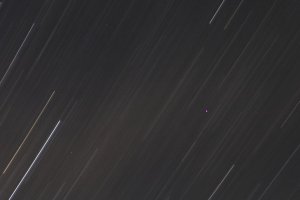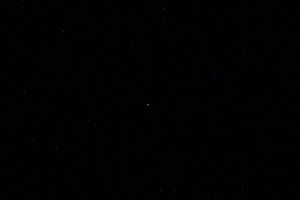I don't think a geostationary sattelite is ruled out yet though. From the straightness of the lines, this section is close to the celestial equator?
I don't think it's ruled out either, but we don't have enough info, and I was trying to lay out what I'd need to know. If I came off as saying "no it's not, absolutely not," I apologize for not being clear.
Technically, we are talking about a
geostationary satelllite, not a
geosynchronous one. The latter is any orbit with a 23 hour, 56 minute period (relative to the stars); that will synch up with the earth's rotation. However, the orbit could be inclined or elliptical, which means the satellite will trace some sort of figure eight in the sky--but return to the same location every 24 hours. If the orbit is perfectly circular and has zero inclination (i.e., it lies in the equatorial plane) then you have a geostationary satellite, it will appear to us, co-rotating in 23 hours, 56 minutes, to be stationary. (The four minute difference between that and 24 hours has to do with the difference between a mean solar day and a sidereal day; if you need/want that explained, please check with wikipedia--it'd be a long digression here.)
The proper altitude for such an orbit would be 35,786 km above some point on the equator. If you are anywhere on the equator, the satellite will appear to be on the celestial equator (hopefully above the horizon!).
But if you are north of the equator, the satellite will appear
to you to be south of the equator, because its MUCH nearer to us than the stars on the celestial sphere. Even though it is in the plane of the earth's equator, it's close by and you are looking at it at a slant. Thus, I wouldn't conclude from the straightness of the lines that it's on the celstial equator, unless the photograph was itself taken near the equator. In fact, if the photograph was taken from (say) England or the United States AND the star trails around it are perfectly straight, then it is absolutely NOT a geostationary satellite; it's way too far "north" for that.
One other thing that makes me suspicious of the idea it might be satellite is the magenta color. I find that to be an odd color for a satellite to be reflecting. Again, not impossible, but it seems easier for me to believe the red and blue are somehow "hot" in that pixel while the green is not.
Another fact that might help narrow it down is to determine whether a hypothetical geostationary object at that spot would have been in the earth's shadow at that time. If so, it'd not be shining like that, unless someone has been putting magenta beacons into GEO.




